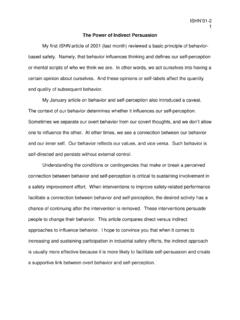Transcription of Improving Safety Leadership
1 Leadership Leadership Improving Safety Leadership Using industrial/organizational psychology to enhance Safety performance By Joshua H. Williams S. Safety PROFESSIONALS ARE charged with reducing employee injuries and promoting a strong Safety culture within their organizations. To achieve this, they must gather and apply information from many sources, including psychology. In fact, much organizational performance including Safety , qual- ity and productivity. During World War I, IOP researchers developed and administered the Army Alpha and Beta intelli- gence tests to more than million soldiers.
2 These information has been gleaned from one of the most tests were used to place enlisted soldiers in special- powerful and proven subdisciplines in psychology, ized areas where their talents would be best used applied behavior analysis. ( , officer training school). These researchers also Little existing research in the Safety field draws developed specific, objective criteria for job perform- from industrial/organizational psychology (IOP), ance evaluations that were used to select and pro- however. This is unfortunate because IOP has been mote officers.
3 During World War II, IOP researchers extensively used in other organizational improve- focused on personnel training, instead of selection ment efforts, such as employee selection, job place- and placement. Situational stress tests were conduct- ment, team building, performance management, ed to better prepare soldiers for the intense distress executive assessment, Leadership and training and frustration of combat. This included flight simu- (Cascio; Saal and Knight 1995). lator assessments of fighter pilots (Buckley; Cohen). To become optimal Safety leaders, Safety profes- Today, IOP is primarily used in the selection, place- sionals should look to IOP as a supplement to ment, training and development of individuals in behavior analysis.
4 This article explains what IOP is organizational settings in order to improve productiv- and examines its impact on Safety Leadership . The ity, quality and Safety (Cascio). This article addresses styles and behaviors of optimal Safety leaders are organizational training and development, with the reviewed, as are motivational styles that predict primary focus on Improving Safety Leadership . good Safety Leadership . In addition, specific guide- lines to motivate employee Safety and guidance on Optimizing Safety Leadership increasing employees' organizational commitment Despite current trends that encourage managers are offered, along with tips for Improving organiza- and executives to stress worker participation and tional Safety culture.
5 Teamwork in order to tap into human creativity and ingenuity (Saal and Knight (1995) 4), heavy-handed, Explaining IOP fear-driven management styles still pervade much of For the past century, IOP focused on the selection the organizational landscape and placement of individuals in organizational set- (Geller and Williams). The end Joshua H. Williams, , is a project tings. Viteles helped define the field by clarifying, result is low employee morale, manager with Safety Performance Solutions, In formulating a program of industrial psychology high turnover, apathy, low job a behavior-based Safety consulting firm in the maximum efficiency of the individual in indus- satisfaction and cynicism.
6 For Blacksburg, VA. He holds a in try and his optimum adjustment are looked upon as Safety professionals, this can Industrial/Organizational Psychology from complementary facets of a single objective (Saal impede implementation and Virginia Tech University. Williams is a member and Knight (1988) 10). That objective is improved maintenance of sound Safety of ASSE's Colonial Virginia Chapter. APRIL 2002 PROFESSIONAL Safety 43. initiatives. Improving Leadership skills among Safety Ensure that other organizational systems do not professionals increases the likelihood of successful encourage noncompliance.
7 Implementation of Safety improvement efforts, Treat employees with dignity and respect. improved Safety culture and reduced injuries (Geller 4) Expert power involves the ability to meet orga- and Williams). nizational objectives and goals. Technical knowl- edge and relevant experience, particularly if it is rare Effective Leadership Styles in the organization, are components of expert power. Leadership The first (and best known) IOP clas- Effective leaders exhibit expert power when they: sification system for Leadership styles promote an image of expertise and credibility.
8 Styles comes from French and Raven, who act confidently and decisively, even in difficult 1) Legitimate power. believed the best leaders use a combi- situations;. 2) Reward power. nation of the following five Leadership stay informed and current, especially with tech- 3) Coercive power. styles: nical knowledge and Safety research;. 4) Expert power. 1) Legitimate power stems from provide employees leading-edge education and 5) Referent power. employee recognition that certain peo- training. ple have the appropriate organization- 5) Referent/charismatic power involves employ- al position to lead others ( , ee feelings of similarity to and liking of the leader.
9 Supervisors). When using legitimate power, good This powerbase relies primarily on interpersonal Safety leaders: relationships, and less on authority, rewards, pun- exercise authority consistently to increase credi- ishment or task knowledge (Bass). When using this bility and promote perceptions of fairness; power, leaders: do not remind employees of differences in orga- impart an extreme vision, a message that breaks nizational levels; away from the ordinary;. communicate with employees in a confident, use bold, unconventional techniques to accom- respectful manner; plish group goals.
10 Actively listen to employee concerns and take make one-on-one appeals to employees in order corrective action to make improvements (Saal and to achieve organizational objectives;. Knight 1995). communicate with passion and enthusiasm. 2) Reward power means leaders have the author- Effective Safety leaders use a combination of all ity and resources to administer valued rewards or to five Leadership styles to motivate and influence help others obtain desired outcomes. Examples in- employees. clude controlling incentives and providing exempla- ry performance evaluations.







